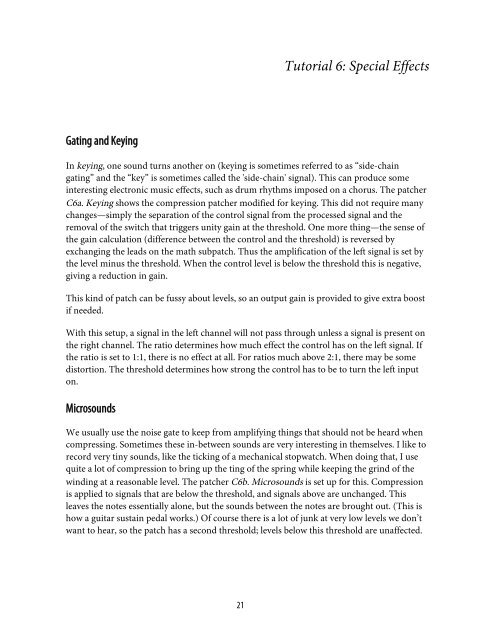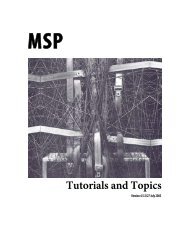MSP; "A Primer on Compression" - Peabody Computer Music
MSP; "A Primer on Compression" - Peabody Computer Music
MSP; "A Primer on Compression" - Peabody Computer Music
Create successful ePaper yourself
Turn your PDF publications into a flip-book with our unique Google optimized e-Paper software.
Tutorial 6: Special EffectsGating and KeyingIn keying, <strong>on</strong>e sound turns another <strong>on</strong> (keying is sometimes referred to as “side-chaingating” and the “key” is sometimes called the 'side-chain' signal). This can produce someinteresting electr<strong>on</strong>ic music effects, such as drum rhythms imposed <strong>on</strong> a chorus. The patcherC6a. Keying shows the compressi<strong>on</strong> patcher modified for keying. This did not require manychanges—simply the separati<strong>on</strong> of the c<strong>on</strong>trol signal from the processed signal and theremoval of the switch that triggers unity gain at the threshold. One more thing—the sense ofthe gain calculati<strong>on</strong> (difference between the c<strong>on</strong>trol and the threshold) is reversed byexchanging the leads <strong>on</strong> the math subpatch. Thus the amplificati<strong>on</strong> of the left signal is set bythe level minus the threshold. When the c<strong>on</strong>trol level is below the threshold this is negative,giving a reducti<strong>on</strong> in gain.This kind of patch can be fussy about levels, so an output gain is provided to give extra boostif needed.With this setup, a signal in the left channel will not pass through unless a signal is present <strong>on</strong>the right channel. The ratio determines how much effect the c<strong>on</strong>trol has <strong>on</strong> the left signal. Ifthe ratio is set to 1:1, there is no effect at all. For ratios much above 2:1, there may be somedistorti<strong>on</strong>. The threshold determines how str<strong>on</strong>g the c<strong>on</strong>trol has to be to turn the left input<strong>on</strong>.MicrosoundsWe usually use the noise gate to keep from amplifying things that should not be heard whencompressing. Sometimes these in-between sounds are very interesting in themselves. I like torecord very tiny sounds, like the ticking of a mechanical stopwatch. When doing that, I usequite a lot of compressi<strong>on</strong> to bring up the ting of the spring while keeping the grind of thewinding at a reas<strong>on</strong>able level. The patcher C6b. Microsounds is set up for this. Compressi<strong>on</strong>is applied to signals that are below the threshold, and signals above are unchanged. Thisleaves the notes essentially al<strong>on</strong>e, but the sounds between the notes are brought out. (This ishow a guitar sustain pedal works.) Of course there is a lot of junk at very low levels we d<strong>on</strong>’twant to hear, so the patch has a sec<strong>on</strong>d threshold; levels below this threshold are unaffected.21
















